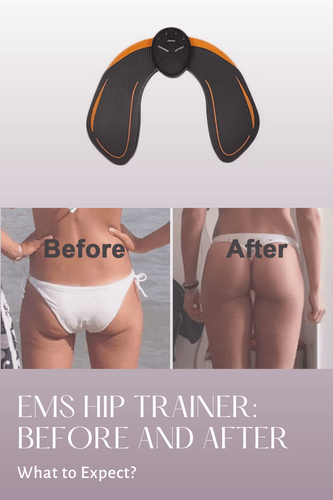Introduction
With the rise of home fitness gadgets. The EMS (Electrical Muscle Stimulation) hip trainer has gained popularity as a tool promising to tone and strengthen the glutes and hips effortlessly. But does it work? Can you rely on this device to achieve the results you’re aiming for, or is it just another fitness fad? In this blog, we’ll explore the science behind EMS technology, user experiences, and whether the EMS hip trainer lives up to its claims.

Understanding EMS Technology
Before diving into the effectiveness of the EMS hip trainer, it's essential to understand how EMS technology works.
EMS, or Electrical Muscle Stimulation, involves sending low-frequency electrical impulses to your muscles through electrode pads placed on the skin. These impulses mimic the signals your brain sends to muscles during physical activity, causing them to contract and relax. The idea is that by artificially stimulating the muscles, you can enhance muscle tone, strength, and endurance.
Origins and Uses of EMS
EMS technology isn’t new; it has been used for decades in physical therapy, sports training, and rehabilitation. Athletes and physiotherapists often use EMS to:
- Rehabilitate muscles after injury: EMS can help maintain muscle tone and prevent atrophy when an injury prevents regular exercise.
- Enhance athletic performance: Some athletes use EMS as a supplement to their training to build muscle strength and endurance.
- Reduce recovery time: EMS can improve blood circulation, aiding in muscle recovery after intense workouts.
Given these established benefits, it's easy to see why EMS technology has been adapted into consumer fitness devices like the EMS hip trainer. But does it work as effectively for the average person?
Does the EMS Hip Trainer Work?
1. Muscle Toning and Strengthening
The primary claim of the EMS hip trainer is that it helps to tone and strengthen the muscles in your hips and glutes. According to some studies, EMS can indeed enhance muscle activation and increase strength when used consistently over time. However, the results may vary depending on several factors:
- Intensity of the stimulation: Higher intensity levels are more likely to produce noticeable results. As they engage the muscles more effectively.
- Duration and frequency of use: Using the EMS hip trainer regularly, for 15-30 minutes per session, 2-3 times a week, is necessary to see any real improvement.
- Combining with exercise: The EMS hip trainer is most effective when used as a supplement to regular physical exercise rather than a replacement.
2. Fat Loss and Cellulite Reduction
Another claim made by some EMS hip trainer manufacturers is that the device can help reduce fat and cellulite. However, the science behind this is less clear:
- Fat loss: EMS does not directly burn fat. While it can increase muscle tone. Which may give the appearance of a leaner physique, fat loss is primarily achieved through a calorie deficit created by diet and exercise.
- Cellulite reduction: Some users report that EMS improves the appearance of cellulite, likely due to increased blood flow and muscle toning. However, these results are generally subtle and vary widely among individuals.
3. Convenience and Ease of Use
One of the EMS hip trainer's biggest selling points is its convenience. It allows users to engage their muscles while performing other tasks, such as working at a desk, watching TV, or relaxing. For those with busy schedules, this can be a significant advantage. However, it’s important to recognise that while convenient, the EMS hip trainer should complement, not replace, more active forms of exercise for optimal results.
What Users Are Saying
User reviews and testimonials provide mixed feedback on the EMS hip trainer. Some users swear by the device, reporting noticeable muscle tone and strength improvements. They appreciate the convenience of being able to engage their muscles without committing to a full workout. Others, however, find the results underwhelming, particularly if they expected rapid or dramatic changes.
Is the EMS Hip Trainer Right for You?
The effectiveness of the EMS hip trainer largely depends on your expectations and how you use the device. Here’s a summary of who might benefit most from the EMS hip trainer:
- Supplemental Fitness: If you’re already active and looking to enhance your workout results, the EMS hip trainer can be a valuable tool for additional muscle engagement.
- Rehabilitation and Recovery: Those recovering from injury or looking to maintain muscle tone during periods of inactivity may find EMS beneficial.
- Convenience Seekers: If you struggle to find time for regular workouts, the EMS hip trainer offers a convenient way to keep your muscles engaged throughout the day.
However, if you’re looking for a quick fix for fat loss or expect dramatic results without putting in the effort with diet and exercise, the EMS hip trainer may not meet your expectations.
Conclusion: Does It Work?
The EMS hip trainer can indeed work, but its effectiveness is influenced by how it’s used and what you expect from it. It’s a tool that can help tone and strengthen muscles, particularly when used as part of a broader fitness routine. However, it’s not a miracle device, and results will vary based on individual factors such as fitness level, consistency of use, and overall lifestyle.
In conclusion, if used correctly and with realistic expectations, the EMS hip trainer can be a worthwhile addition to your fitness arsenal. Just remember, the best results come from combining it with a balanced diet, regular exercise, and a commitment to your overall health and fitness goals.





